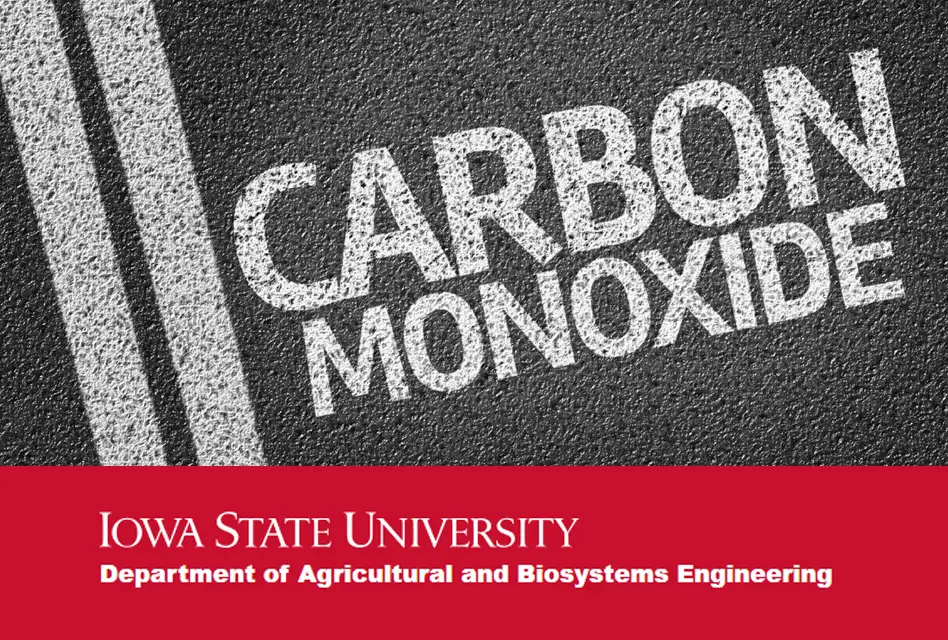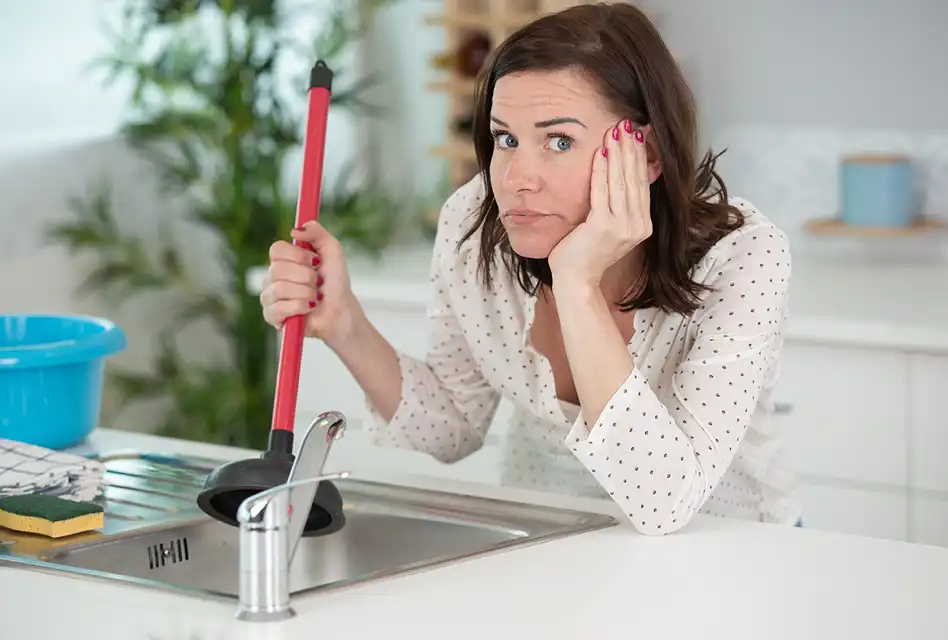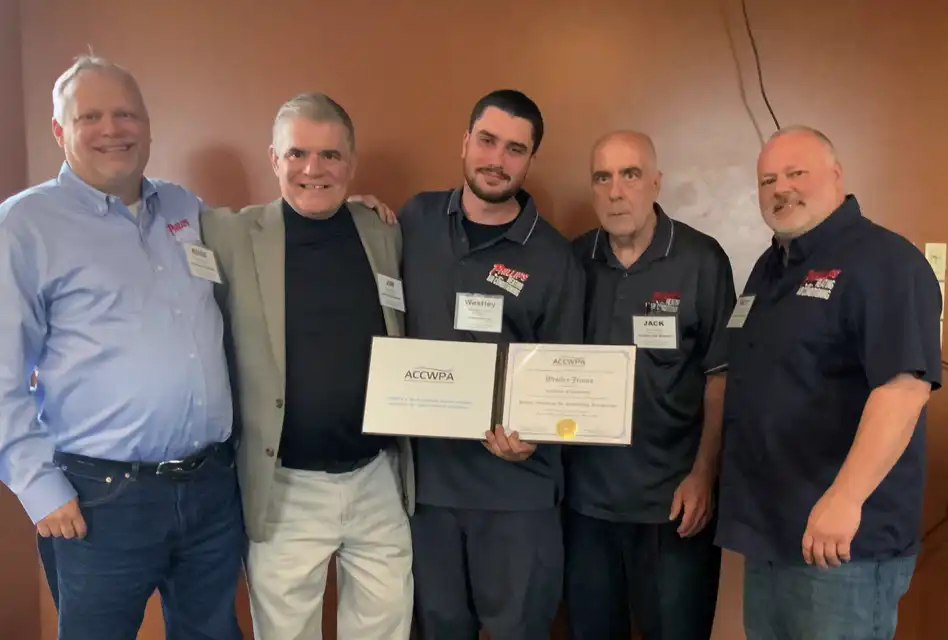CARBON MONOXIDE POISONING
Checking for Complete Combustion
Fossil fuels contain carbon (C) and hydrogen (H). During complete combustion carbon and hydrogen combine with oxygen (O2) to produce carbon dioxide (CO2) and water (H2O). During incomplete combustion part of the carbon is not completely oxidized producing soot or carbon monoxide (CO). Incomplete combustion uses fuel inefficiently and the carbon monoxide produced is a health hazard.
A properly designed, adjusted, and maintained gas flame produces only small amounts of carbon monoxide, with 400 parts per million (ppm) being the maximum allowed in flue products. Most burners produce much less, with between 0 and 50 ppm being typical. During incomplete combustion, carbon monoxide concentrations may reach levels above 7,000 ppm. Even a small amount of spillage into occupied structures from appliances producing large amounts of CO is a health risk and can be a threat to life.
Incomplete combustion occurs because of:
* Insufficient mixing of air and fuel.
* Insufficient air supply to the flame.
* Insufficient time to burn.
*Cooling of the flame temperature before combustion is complete.
Typical reasons for incomplete combustion in residential heating appliances include:
* Blocked vent systems.
* Blocked flue passages in heating appliances.
* Air shutter on burner not opened sufficiently.
* Gas orifices too large or too small (usually too large).
* Manifold gas pressure too high or low (usually too high).
* Rust, scale, or soot on burner.
* Burner installed incorrectly.
* Flame impinging on cold surface.
* Insufficient combustion air to appliance.
* Downdrafting of vent system.
* Failure of power-vent or induced draft blowers.
* Loss of integrity of the heat exchanger (cracked, rusted, or holes in heat exchanger).
* Physical disturbance of the flame (i.e., strong air currents blowing on the flame.)
To reduce the risks of CO poisoning, obtain and follow carefully all the manufacturers’ recommendations for inspection and maintenance. The following are recommended additional steps for servicing and inspecting gas heating appliances:
1. Visually inspect the burner and flame, looking for rust, soot, discoloration, and abnormal flame color or pattern.
2. Visually check the heating appliance for evidence of flame roll-out, downdrafting, and spillage. Burned wires, soot, rust, scale, and “tracking” of combustion products are signs of problems.
3. Check the vent system for proper design, integrity, and draft.
4. Check adequacy of combustion air and make-up air.
5. Verify that vent system functions under “worst-case” depressurization of the dwelling.
6. Check flue passages in appliance for blockage or restriction– clean if necessary.
7. Visually inspect heat exchanger for integrity.
8. Check manifold gas pressures using a manometer and adjust if necessary.
9. Check gas flow rate to appliance (on metered appliances).
10. Measure CO in flue products using an electronic CO analyzer with digital display.
Additional steps which help determine the cause of a heating appliance carbon monoxide problem include:
11. Verify proper combustion using a combustion analyzer with capability to measure carbon monoxide and oxygen content.
12. Determine leakage areas and pressure differences in the structure and vent system using a blower door and micromanometer.
13. Check for proper gas orifice size.
14. Continuously monitor carbon monoxide concentrations in the structure.
VISUAL INSPECTION OF THE FLAME
Visual inspection of the burner will reveal obvious problems including rust, scale, or soot. Obvious flame pattern disruptions or improper color indicates a problem with combustion. Unfortunately, visual inspection is NOT sufficient to verify proper combustion. Burners producing EXTREMELY high concentrations of carbon monoxide can burn blue. Conversely, burners producing little carbon monoxide can burn yellow.
Carbon monoxide is a colorless, odorless, tasteless, non-irritating and highly poisonous gas at low concentrations. Because it is not possible to reliably determine if a burner is producing excessive carbon monoxide visually, the use of an electronic carbon monoxide analyzer with digital display is recommended. The American Society of Heating, Refrigerating, and Air Conditioning Engineers, Inc. states “It is desirable through the use of suitable indicators to determine whether or not carbon monoxide is present in flue gases” (ASHRAE Handbook, pg 26.3). Use of an instrument to measure carbon monoxide concentrations outdoors, inside the structure, and in the flue products is critical to insure the heating appliance is operating safely.
Blue Flame Burner
Flame Color: Blue
Can be either high or low CO, no reliable visual method of determining CO production.
Flame Color: Yellow
Usually indicates high CO production. One cause– insufficient primary air opening.
Yellow Flame Burner
Flame Color: Blue
Combustion not as designed, Can be either high or low CO, no reliable visual method of determining CO production.
Flame Color: Yellow
Can be either high or low CO, depends on adequate secondary air for complete combustion, no reliable visual method of determining CO production.
PRODUCTION OF CARBON MONOXIDE
Burner and combustion chamber design affects the amount of carbon monoxide produced. Methods of reducing carbon monoxide production include providing excess air, increasing burner chamber temperature, and providing a large combustion zone. Unburned combustion products will continue to be oxidized in a hot combustion chamber with excess air. Unfortunately, excess air, high temperatures, and large combustion zones reduce efficiency and increase costs.
Simple actions, such as placing a cold pan on a kitchen stove top burner or blowing air from a fan across an unvented burner can increase carbon monoxide production. Oxidation of the combustion gases stops when the hot gases impinge on the cold pan or are cooled by the air from the fan. Any carbon monoxide not yet oxidized will be released into the room.
Adjustment of the burner affects the amount of CO produced. Insufficient primary burner air increases CO production. Restricted air inlets often produce a noticeable disruption of the flame and a change from blue to yellow.
Another cause of insufficient primary air and incomplete combustion is excess gas flow to the burner. Excess gas flow seldom produces a noticeable disruption of the flame or change of color. Excess gas flow can be caused by excess gas pressure or by oversized gas orifices. Gas regulators can fail, go out of adjustment, not be correctly field-derated for altitude, or be adjusted upward by field technicians to increase heat output. Overfiring is especially dangerous because:
- High CO production can occur.
- Excess heat is produced which can damage heat exchangers.
- Excess combustion products are produced which can exceed capacity of heating appliance flue vents and vent systems.
- The flame can continue to burn blue, giving no obvious visual indication of the problem.
Typically warm-air furnace manufacturers require checking of the gas flow and gas pressure upon initial start-up and allow no over-firing. To find and correct problems caused by excess gas flow it is important to check gas flow, gas pressure, orifice sizing, and carbon monoxide concentrations in combustion products.
HOLES IN HEAT EXCHANGER
Large holes in a heat exchanger are dangerous. Air forced through holes by the circulating fan increases the production of CO by disrupting the flame. The air flow increases the amount of combustion products spilling into the living quarters by disrupting the air flow through the appliance vent flue. In most natural draft and induced draft furnaces, high pressure on the furnace blower side of the heat exchanger prevents combustion products from flowing directly into the circulation air. Usually combustion products enter the house because of vent failure or spillage. In power vent and pulse combustion furnaces high pressures on the combustion side can force combustion products directly through holes into the circulating air and the house. Combustion products contain large amounts of carbon monoxide and water vapor, which can smother flames or lead to increased rust and corrosion of the heat exchanger. Flame roll-out occurs in severe cases.
Holes in heat exchangers can be found by direct observation, using either mirrors or by disassembling the unit. Some direct vent sealed combustion units can be tested by sealing the inlet and outlet and pressure testing. Smoke bombs, odor tracing and salt sprays have been used, but have not been totally acceptable. The American Gas Association has developed a heat exchanger test method using tracer gases which they have determined to be more reliable and accurate. Observation of flame disruption when the furnace blower turns on will reveal large holes. Measurement of carbon monoxide in flue products using CO analyzers reveals incomplete combustion caused by air flow through holes.
Combustion gases should be sampled before draft hood dilution. In natural draft appliances the flue passages (chambers) at the top of the appliance can usually be reached, with a probe, through the draft diverter or hood. For equipment with several burners and separate flue passages (chambers), each burner must be checked separately by inserting the probe into the top of each chamber. It is important to insert the probe a sufficient distance into the flue chambers to ensure undiluted combustion products are being sampled. Sealed combustion units can often be sampled most easily at the outdoor exhaust outlet. Locations that will not give an accurate reading of combustion gases include: the perimeter of the draft hood (this will represent room air), directly above the flame (sampling here may give an erroneous high reading), and at furnace air outlets (which contain a mixed sample).
CARBON MONOXIDE ANALYZERS AND DETECTORS
There are many potential causes of carbon monoxide production and spillage of combustion products into living areas. Many causes are accidental and unpredictable; i.e.; holes in heat exchangers develop or enlarge after inspection, vent systems fail under strong wind conditions, pressure regulators stick, or air inlets and vents freeze.
To protect against accidental carbon monoxide poisoning, the U.S. Consumer Product Safety Commission, the Iowa Department of Public Health, and Iowa State University Extension recommend that every home have at least one U-L listed carbon monoxide detector on every floor with sleeping quarters. Heating appliances should be inspected and maintained yearly by a qualified heating contractor. Because flame color is not a reliable indicator of carbon monoxide production from a burner the heating contractor must use a carbon monoxide analyzer to inspect and maintain burners.
Author: Thomas H. Greiner, Extension Agricultural Engineer







